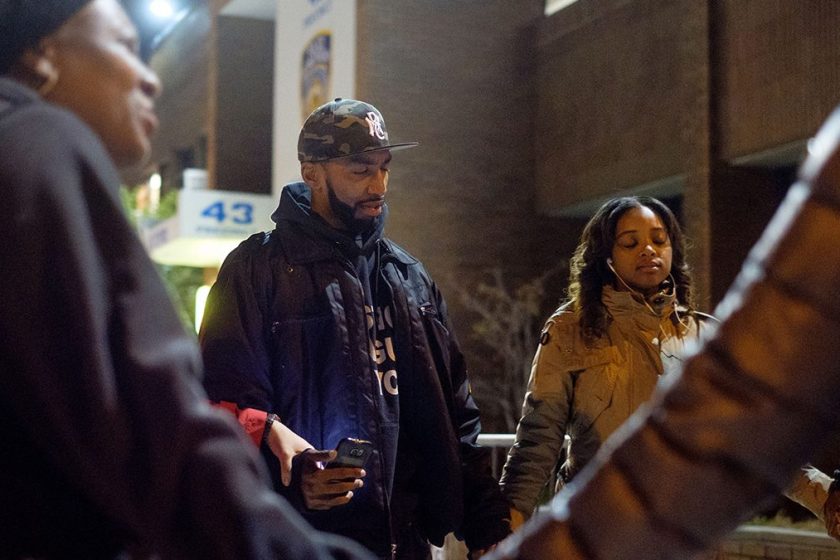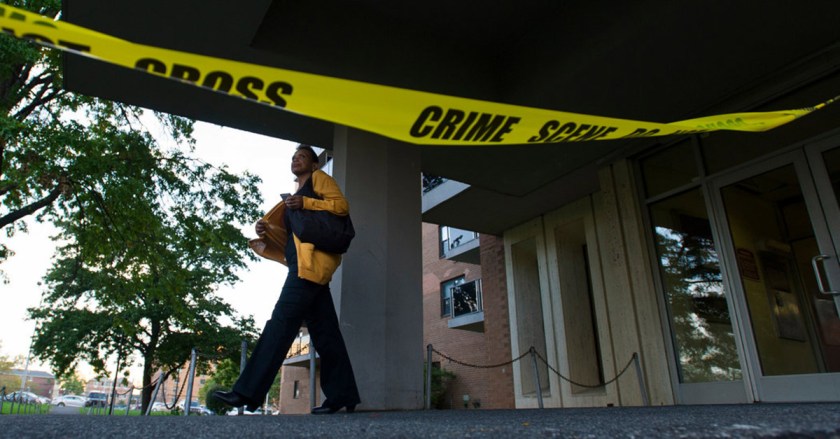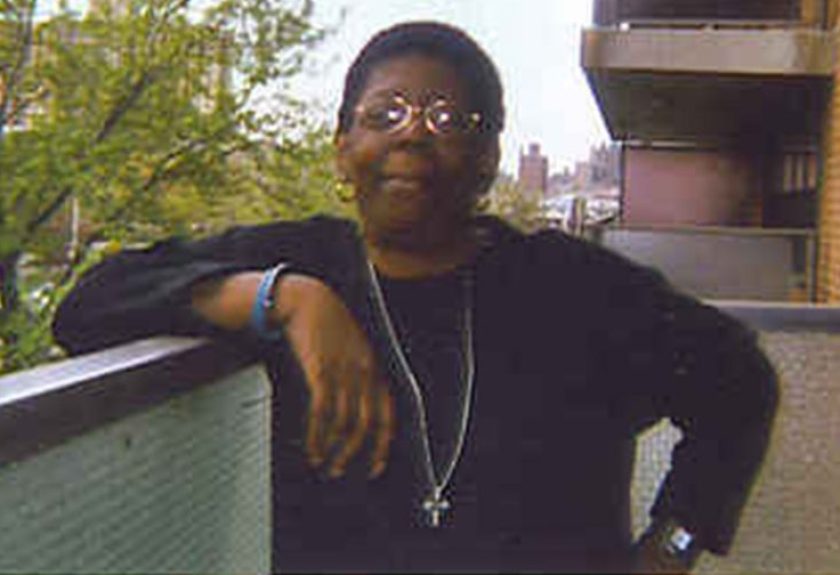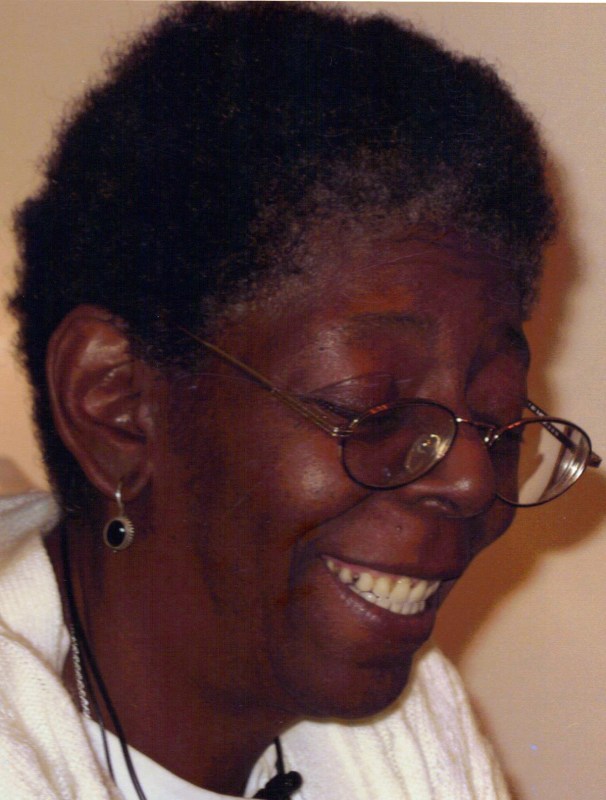
How did Deborah Danner—an intelligent, well-educated, and self-aware middle-class woman—end up alone, with a baseball bat in her hand, shot dead in her apartment by police? And how many other forgotten men and women are just like her?
By Michael Weinreb and Steve Klinsky
Paranoid thoughts would impede on Danner at otherwise quiet moments, shattering the mundanity of her daily existence, seizing her psyche as she washed dishes or cleaned her apartment or read a book. This was her illness creeping in, her schizophrenia manifesting itself. This, she said, was what led her to get so dirty that she was forced to defecate on the street since no shopkeeper or restaurant owner would allow her to use their restroom; this was what led her to wander the streets of New York City late at night, carrying a knife and searching for a public place in which to kill herself. This was what led her to call one of the few people she trusted and ask them to help pay for her to change the locks of her apartment again and again.
In the end, schizophrenia did wind up killing Danner, though not at her own hands: On October 18, Danner, age 66, was shot in her Bronx apartment by police sergeant Hugh Barry after reportedly threatening him with scissors and swinging a baseball bat at the officer after a neighbor called 911. The shooting was yet another episode of police violence to earn widespread condemnation from protestors and local officials; it was immediately condemned as “tragic and unacceptable” by New York City Mayor Bill de Blasio, and by the city’s police chief, James O’Neill.
“What is clear in this one instance: We failed,” O’Neill said. “I want to know why it happened.”
And yet, what is perhaps most remarkable about Danner’s death is that she foreshadowed it herself. In an eloquent six-page essay written in 2012, titled “Living With Schizophrenia,” Danner alluded to the death of another mentally ill woman, Eleanor Bumpurs, who was killed by police in the Bronx in 1984.
“They (the police) used deadly force to subdue her because they were not trained sufficiently in how to engage the mentally ill in crisis,” Danner wrote. “This was not an isolated incident.”

Even more than police procedure, however, Danner’s letter stressed the loneliness and stigma attached to anyone with a serious mental illness.
“Definition of Stigma,” wrote Danner, quoting Merriam-Webster, “(a) a scar left by a hot iron:…BRAND (b) a mark of shame or madness (mental illness) (c): an identifying mark or characteristic; specifically, a specific diagnostic sign of a disease… I’ve included the definition of stigma in this essay because those who practice it should be reminded of what it means and, conversely, the damage it does to those it is directed at… Generally speaking, those who don’t suffer believe the worst of those of us who do. We’re treated with suspicion as liars who can’t be trusted to control ourselves. We’re asked to accept less than our natural rights to life, liberty and pursuit of happiness. Often our movements are curtailed…. We’re rarely employed in the mainstream (unless like me, we hide our affliction(s))… All of the above is a prescription for misery… The saddest aspect of this sort of marginalization of the mentally ill is the fact that many remain untreated (the incarcerated mentally ill, the homeless mentally ill) and suffer terribly.”
**
According to her essay, Deborah Danner began exhibiting symptoms of schizophrenia around the age of 30, though her uncle, Wallace Cooke Jr., a former police officer, told reporters that Danner started showing signs while attending City College and Lehman College in New York City. Her mother, a nurse at Rikers Island prison, immediately began to seek help for her daughter, Cooke said, but it proved an ongoing challenge, as Danner herself would admit. She never married or had children; the disease, she wrote, took a toll on “my life, my career, and my relationships.”
According to the National Alliance of Mental Illness, roughly 1.1% of the nation’s adults—or about 2.5 million people—suffer from schizophrenia.
Her day-to-day existence was complicated by the emotions that schizophrenia brought out in her, and led her to mistrust the same people who insist they were trying to help her. Danner wrote that “my nuclear family disappointed me… my extended family too,” and that her family held her “at arm’s length.” And yet according to media reports, her mother—who died in 2006—had arranged for Danner to have her own apartment in the same Bronx apartment building where she and Deborah’s sister Jennifer lived. In the aftermath of her mother’s death, Jennifer was often there when Danner had a mental breakdown and had to be transported to the hospital. Even so, Danner harbored an ongoing sense of mistrust toward those who were trying to help, as her essay notes—she claimed that the doctors and caregivers who treated her were often influenced by family members “who don’t and didn’t really know me.”

“What’s that old adage: ‘You always hurt the one you love?’” Danner wrote. “This is/has been very true where I and my familial relationships have been concerned.”
It’s impossible to know, of course, how much of that suspicion stemmed from Danner’s illness. What is clear from her essay, and from the testimonies of those who knew her best, is that Danner was well-read and intelligent (she lamented that her intelligence often impeded her release from hospitalization after suffering from episodes of schizophrenia and that it was “not a defense”). Her apartment was lined with books. She would take art and acting classes and employment programs at Fountain House in Manhattan, a gathering place for people with mental illness. She would often draw caricatures of how people looked to her when she wasn’t well.
“People have these images about mental illness where you’re acting unusual all the time,” Kenn Dudek, director of Fountain House, told RealClearLife. “It’s not true. People appear normal most of the time… Deborah did have a lot of things she liked to do.”
She also enjoyed writing poetry, and she regularly attended Trinity Church in Lower Manhattan, where Reverend Matthew Heyd was a pastor (and where Danner was baptized in 2006). Danner then followed Heyd when he left to become Rector of the Church of Heavenly Rest on Fifth Avenue and 90th Street in Manhattan, often sitting in the front row and knitting. She knit blankets for both of Heyd’s children when they were born, and she often attended adult education classes at the church. She and Heyd would speak regularly about her challenges, and she would call him frequently. And yet it was often difficult, Heyd says, because she required resources beyond what the church could provide.

“She loved being part of our community, but she was struggling with her illness and how to handle the baggage that came with her illness,” Heyd told RealClearLife. “She often felt alienated and alone.”
Rikki Tahta, who attended the Church of Heavenly Rest with Danner, told RealClearLife he began chatting with her one Sunday morning about a sermon relating to the politics of the Roman Empire around the time Christianity was taking hold. They went for a cup of coffee afterward; Danner told Tahta that she was experiencing difficulties with her bank account, and Tahta offered to help her out. She called him a month or so later to thank him, and Tahta says he had no sense that Danner was mentally ill.
“I never saw that side of her—I just saw a woman who was an educated middle-class woman, and that’s what floored me,” Tahta said of Danner, who was African-American. “In my world, people don’t break in and shoot middle-class, educated women. And I wouldn’t be frightened of her yielding a baseball bat—I’d just take it off her.”
**
According to her essay, Danner worked as an information technology professional, though her uncle said he wasn’t aware Danner held a full-time job. Danner herself said that her family didn’t know what she did, and never really asked—and yet also claimed that her mother and sister “felt that the industry I chose to devote myself to was the cause of my illness.”
Neighbors said Danner started to go downhill after her mother’s death in 2006. “She used to speak to people when her mother was still alive,” one neighbor told the New York Daily News. She showed up sporadically at Fountain House in the five years before her death—maybe two to three times a year, often to inquire about an art scholarship offered by Fountain House—and according to Dudek, she was in and out of psychiatric hospitals. She would often tell people that she was schizophrenic, but that she was asymptomatic, yet she would still suffer from episodes. Multiple people who knew Danner told RealClearLife they believed that Danner was off her medication for a period of time that prefigured her death.
At least four times, neighbors called 911; they’d hear her hollering and screaming and “talking like she was going to battle somebody.” When her sister applied to be her guardian after her mother’s death, Danner refused and sought a lawyer. About a year ago, she met an attorney for the state’s Mental Hygiene Legal Service, and they had a long conversation about books and writing and art. Dudek believes the attorney agreed to help Danner remove her sister as her legal guardian, and may have misunderstood the severity of Danner’s illness.
“The thing about the symptoms of these illnesses is that they cause fear in people,” said Kenn Dudek, director of Fountain House recovery center. “But once you understand the nature of the symptoms, you lose the fear.”
“She definitely needed somebody to look out for her on a more regular basis,” Dudek told RealClearLife. “I wish we had the resources, but we see 1,300 people a year here… The biggest problem for people with mental illness is isolation. The way these illnesses work is that people lose connections over time. Usually the last ones to hang in with these people are their family.”
Yet Danner refused to accept help from her sister. And so after a neighbor called 911 on the evening of October 18, police entered Danner’s seventh-floor apartment in the Castle Hill neighborhood of the Bronx. According to reports, the sergeant convinced Danner to drop a pair of scissors, but she picked up a wooden bat and lunged at him. The sergeant fired his revolver twice, striking her in the torso.
She died roughly an hour later; her sister was reportedly waiting outside, presuming that police would once again transport Danner to a mental-health facility, as they had done following previous incidents. New York City has begun providing rank-and-file police officers with more advanced training on how to deal with mental illness, but according to The New York Times, the training has only reached about 4,400 of the NYPD’s roughly 36,000 officers. The sergeant who shot Danner had not yet received the training and perhaps it would have made no difference. The New York Times also reported that on November 2, 2016, shortly after Danner was killed, another emotionally disturbed Bronx resident—a man—was killed by police, this time with an electric stun gun.
**
Whatever the cause or effects, Deborah Danner was far from alone in her suffering. According to the National Alliance of Mental Illness, roughly 1.1% of the nation’s adults—or about 2.5 million people—suffer from schizophrenia; 2.6% from bipolar disorder; 6.9%—or 16 million—had at least one major depressive episode in the past year; and 18.5%—or 43.8 million adults—experience mental illness in a given year.
Dudek says many sufferers like Danner often fall through the cracks because the system provides for short-term solutions, but doesn’t allow for them to be monitored over months or years.

“There’s a way to do this but you’ve got to put some of the resources into working with people on a more regular basis,” Dudek said. “The thing about the symptoms of these illnesses is that they cause fear in people. But once you understand the nature of the symptoms, you lose the fear.”
This overarching notion of understanding and acceptance comprised the theme of a homily the Reverend Heyd gave in memory of Danner at Heavenly Rest shortly after her death.
“The essay she wrote ends with a paragraph about being connected through her church,” he said. “And I said that’s what church should be for everybody—you can be a part of it and be accepted. Deborah understood deeply what church should be. And I found that deeply affecting. But we as a faith-based community have a responsibility to support people like Deborah, to stay connected to folks who are struggling, and even in difficult circumstances, with people who are in need. And we have that responsibility as a society, too.”
So, as RealClearLife connects our readers to everything beautiful, healthy, glamorous, and good in the world, we connect you to Deborah Danner: a forgotten and lost woman who deserves our respect. We also connect you to the words of poet Leonard Cohen:
Ring the bells that still can ring.
Forget your perfect offering.
There is a crack in everything.
That’s how the light gets in.
For more of RealClearLife’s “Best of 2016,” click here.
This article was featured in the InsideHook newsletter. Sign up now.























